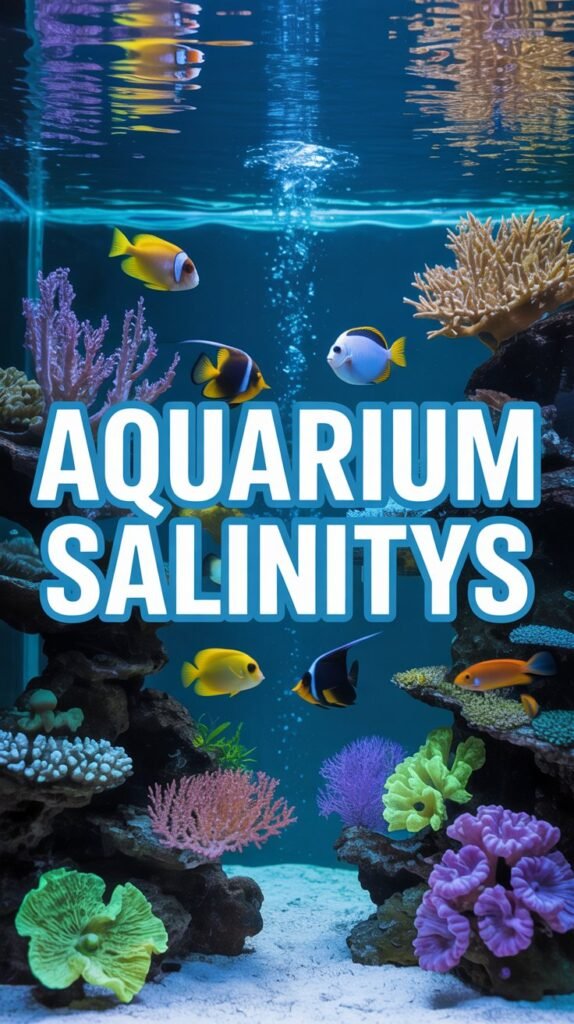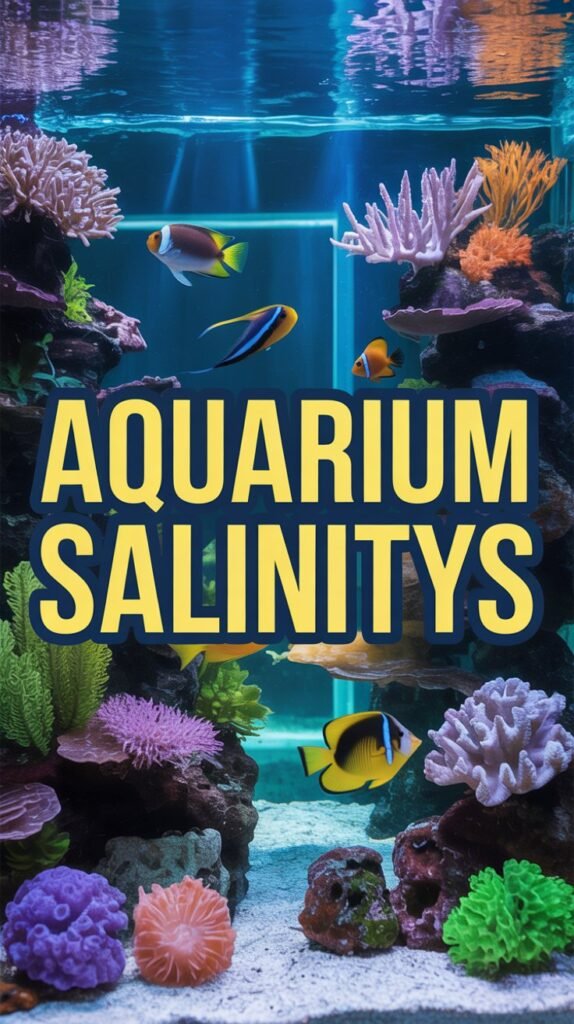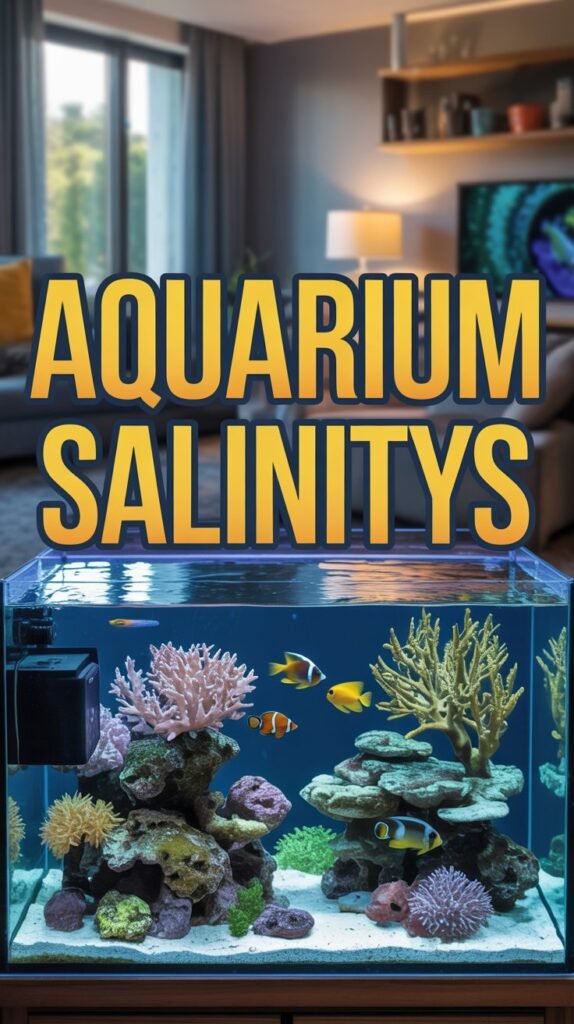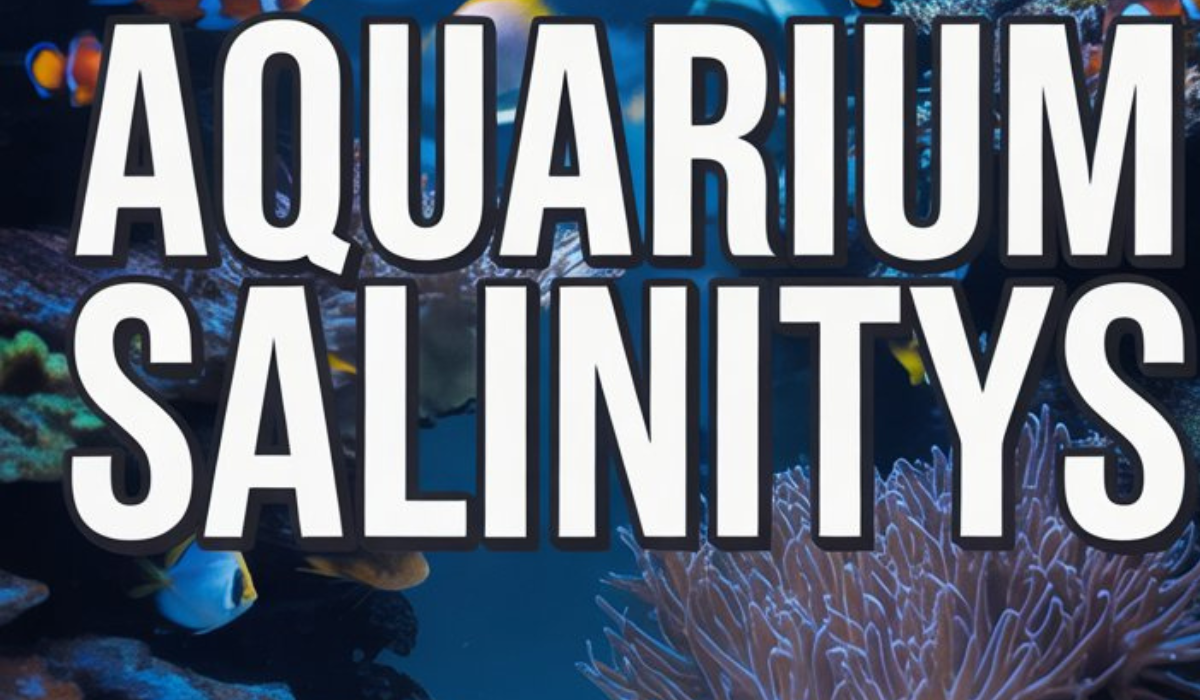Maintaining proper aquarium salinity is one of the most important aspects of fishkeeping, especially for marine and brackish aquariums. Whether you’re setting up a saltwater reef tank, keeping brackish fish species, or experimenting with mixed environments, understanding and managing salinity ensures your aquatic life thrives.
In this comprehensive guide, we’ll explore what salinity is, why it matters, how to measure and maintain it, and what can happen when salt levels are not in balance. By the end, you’ll have all the knowledge needed to master aquarium salinity management like a pro.
What Is Aquarium Salinity?
Aquarium salinity refers to the concentration of dissolved salts (mainly sodium chloride) in the water. It is a crucial parameter in marine and brackish aquariums, where the health of fish, corals, and invertebrates depends on stable salt levels.
Salinity affects:
- Osmoregulation in fish (how they balance water and salt in their bodies)
- Coral and invertebrate metabolism
- Bacterial and microbial balance
- Water chemistry stability
Salinity is measured as:
- Specific gravity (SG): the density of saltwater compared to pure water.
- Parts per thousand (ppt): grams of salt per liter of water.
For example:
- Freshwater: 0 ppt
- Brackish water: 1–20 ppt
- Marine water: 30–35 ppt
Why Aquarium Salinity Matters

Maintaining proper salinity is vital because aquatic species are adapted to live within specific salt concentrations. Even minor changes can lead to osmotic stress, which affects fish respiration, hydration, and overall health.
Key reasons salinity matters:
- Fish health and comfort: Fish maintain internal salt levels that differ from their environment. A stable external salinity helps them regulate internal fluids.
- Coral and invertebrate growth: Corals and shrimp rely on precise salt concentrations to absorb minerals and maintain structure.
- Bacterial balance: Beneficial bacteria that handle biological filtration thrive at specific salinities.
- Water chemistry stability: Salinity influences pH, alkalinity, and calcium levels, which are critical for reef systems.
Inconsistent salinity can cause fish stress, coral bleaching, or even tank crashes.
Ideal Salinity Ranges by Aquarium Type
Different aquariums require different salinity levels. The ideal range depends on the species you keep and the ecosystem you’re replicating.
| Aquarium Type | Salinity (ppt) | Specific Gravity (SG) |
|---|---|---|
| Freshwater | 0 ppt | 1.000 |
| Brackish Water | 1–20 ppt | 1.005–1.015 |
| Marine Aquarium | 30–35 ppt | 1.020–1.026 |
| Reef Aquarium | 34–35 ppt | 1.024–1.026 |
| Coral Frag Tank | 35 ppt | 1.026 |
Keeping your salinity consistent within these ranges ensures optimal health and growth of aquatic organisms.
Understanding Specific Gravity (SG)
Specific gravity (SG) is the most common way aquarists measure salinity. It compares the density of saltwater to that of pure water.
- Pure water has an SG of 1.000.
- Seawater typically measures 1.025.
As water evaporates, the salt concentration increases, raising SG. Therefore, it’s important to top off with freshwater, not saltwater, to maintain balance.
Temperature and SG
Temperature affects density—warmer water is less dense, which can skew readings. Always calibrate your measuring tools to the temperature of your tank (usually 25°C or 77°F).
How to Measure Aquarium Salinity

Accurate measurement is key to maintaining stability. There are several tools for this purpose, each with different precision levels.
1. Hydrometer
A hydrometer measures the buoyancy of water.
- Pros: Affordable and easy to use.
- Cons: Less accurate, affected by temperature and air bubbles.
How to use:
- Fill the hydrometer with tank water.
- Wait for the needle or float to settle.
- Read the specific gravity on the scale.
2. Refractometer
A refractometer measures how light bends through the water.
- Pros: Very accurate, quick, reliable.
- Cons: Requires calibration and maintenance.
How to use:
- Place a drop of water on the prism.
- Look through the eyepiece.
- Read the SG or ppt value.
3. Digital Salinity Meter
Modern digital meters provide instant readings.
- Pros: Highly accurate and easy to read.
- Cons: More expensive and requires batteries.
Best for: Professional or reef aquarium setups where precision is vital.
How to Adjust Aquarium Salinity
Maintaining the correct salinity involves adding or removing salt and water carefully.
To Increase Salinity:
- Mix marine salt mix with freshwater in a separate container.
- Add slowly to your tank over several hours or days.
- Test frequently to avoid shocking fish.
To Lower Salinity:
- Add freshwater only (no salt) slowly.
- Replace small amounts (5–10%) at a time.
- Never dilute too quickly—rapid changes stress fish and corals.
Pro Tip: Always prepare saltwater in a separate bucket and aerate for 24 hours before adding to your aquarium. This ensures complete dissolution and stable chemistry.
How to Mix Saltwater for Your Aquarium
Making saltwater correctly ensures consistent salinity and a safe environment.
Steps:
- Use RO/DI water: Reverse osmosis water removes impurities.
- Add marine salt mix: Follow the manufacturer’s instructions (usually 1/2 cup per gallon).
- Stir and aerate: Mix with a powerhead for 24 hours.
- Check salinity: Adjust by adding more salt or freshwater.
- Match temperature: Ensure the same temperature as your aquarium before adding.
Recommended Salt Mix Brands:
- Instant Ocean
- Red Sea Coral Pro
- Tropic Marin Pro Reef
- Reef Crystals
Each brand offers different trace element compositions suitable for fish-only or reef tanks.
The Relationship Between Salinity and Other Water Parameters
Salinity interacts with multiple parameters in your aquarium. Changing one can influence others.
| Parameter | Effect of High Salinity |
|---|---|
| pH | Slightly increases due to ions |
| Alkalinity | Can rise with salt content |
| Calcium/Magnesium | Often increases with marine salt |
| Dissolved Oxygen | Decreases as salinity increases |
| Temperature | Warm water lowers density, affecting readings |
Balancing these together ensures a stable ecosystem.
Effects of Incorrect Salinity Levels

Unstable salinity can lead to serious health problems for your fish and corals.
1. Low Salinity Effects
- Fish experience osmotic stress (water enters their body uncontrollably).
- Corals may lose color or retract polyps.
- Bacteria may die off, disturbing the nitrogen cycle.
2. High Salinity Effects
- Fish dehydrate as water leaves their bodies.
- Corals bleach or produce excess mucus.
- Invertebrates like snails or shrimp may die quickly.
3. Rapid Fluctuations
- Even a 0.002 SG change within hours can shock sensitive species.
- Gradual adjustments are always safer.
Aquarium Salinity for Different Species
Each type of fish or aquatic organism has its preferred salinity range.
1. Marine Fish
- Require full seawater salinity (1.020–1.026 SG).
- Examples: Clownfish, Tangs, Wrasses, Gobies.
2. Reef Corals
- Prefer slightly higher salinity (1.025–1.026 SG).
- Sensitive to even small fluctuations.
3. Brackish Fish
- Thrive in medium salinity (1.005–1.015 SG).
- Examples: Mollies, Archerfish, Scats, Monos.
4. Invertebrates
- Shrimp, snails, and starfish are highly sensitive.
- Always acclimate them slowly when adjusting salinity.
How Evaporation Affects Aquarium Salinity
When water evaporates, only pure water escapes, leaving salts behind. This gradually increases salinity.
How to Fix:
- Top off daily with freshwater (not saltwater).
- Use an auto top-off (ATO) system for consistency.
- Regularly check salinity, especially during hot weather.
Tip: Avoid letting water evaporate more than 5–10% of tank volume before topping off.
How to Acclimate Fish to New Salinity Levels
When introducing new fish or invertebrates, acclimation is essential.
Drip Acclimation Method:
- Float the bag in the tank for 15 minutes to equalize temperature.
- Transfer fish and bag water to a container.
- Use airline tubing to drip tank water (2–4 drops/sec) for 45–60 minutes.
- Gently net fish and transfer to your aquarium.
This slow process allows fish to adapt safely to the new salinity and chemistry.
Troubleshooting Common Salinity Issues
| Problem | Cause | Solution |
|---|---|---|
| Rising salinity | Evaporation | Top off with freshwater daily |
| Falling salinity | Over-dilution | Add saltwater gradually |
| Unstable readings | Faulty tools or bubbles in hydrometer | Use refractometer and ensure no air bubbles |
| Cloudy saltwater | Incomplete mixing | Mix for 24 hours with strong aeration |
| Coral stress | Rapid salinity shifts | Adjust slower and monitor closely |
Automation and Monitoring Systems
Modern aquarium technology makes salinity management easier.
Recommended Tools:
- Auto Top-Off Systems (ATO): Replace evaporated water automatically.
- Smart Sensors: Monitor and send alerts via mobile apps.
- Dosing Pumps: Maintain consistent salt and mineral balance.
Brands like Neptune Apex and Hydros Control offer smart salinity tracking for high-end setups.
The Role of Salinity in the Nitrogen Cycle
In marine and brackish tanks, beneficial bacteria adjust to specific salinities. Sudden changes can kill these colonies, leading to ammonia and nitrite spikes.
To prevent crashes:
- Maintain consistent salinity during water changes.
- Match new saltwater to the same SG before adding.
- Avoid changing more than 10–15% salinity at once.
Stable salinity supports strong biological filtration and prevents water quality issues.
Tips for Maintaining Stable Aquarium Salinity
- Top off with freshwater daily.
- Use a reliable refractometer for accurate readings.
- Mix saltwater 24 hours in advance to ensure stability.
- Perform consistent water changes (10–20% weekly).
- Avoid adding dry salt directly to the tank.
- Acclimate new fish slowly to prevent osmotic shock.
- Log your salinity readings weekly for long-term tracking.
- Check equipment like heaters and ATOs regularly for performance.
- Keep your tank covered to reduce evaporation.
- Use high-quality marine salt mixes to ensure proper mineral balance.
Maintaining Salinity in Reef Tanks
Reef tanks require the highest salinity stability due to the sensitivity of corals and invertebrates. Even small changes can harm coral health.
Reef tank best practices:
- Keep SG between 1.024–1.026 consistently.
- Use RO/DI water only to avoid contaminants.
- Monitor daily with digital salinity probes.
- Perform small, frequent water changes instead of large ones.
Long-Term Salinity Management
Salinity management is not a one-time task—it’s ongoing. Over time, evaporation, water changes, and salt creep affect balance.
What Is Salt Creep?
Salt creep is the white residue that forms around the tank edges due to splashing and evaporation. While harmless, it indicates salt loss.
Fix: Clean with freshwater and adjust salinity if levels drop.
Maintaining a stable salinity ensures long-term tank stability, healthy fish, and vibrant coral growth.
Conclusion
Aquarium salinity is the foundation of marine and brackish aquarium health. Whether you keep hardy mollies or delicate coral reefs, maintaining stable salt levels ensures a thriving aquatic ecosystem. With regular testing, slow adjustments, and high-quality equipment, you can easily manage salinity like an expert.
Remember, stability is everything. Even the smallest change can impact life underwater. Stay consistent, test often, and your aquarium will reward you with beauty and balance.
FAQs About Aquarium Salinity
Q1. What is the ideal salinity for a marine aquarium?
The ideal salinity for a marine tank is 1.020–1.026 SG (30–35 ppt), depending on whether it’s a fish-only or reef aquarium.
Q2. How often should I check salinity levels?
Check your aquarium’s salinity at least twice a week, or daily if you notice evaporation or water loss.
Q3. Can I use table salt to increase aquarium salinity?
No, table salt lacks essential trace minerals and may contain additives. Always use marine-grade aquarium salt mix.
Q4. How do I fix high salinity in my tank?
Add freshwater slowly to lower salinity. Avoid large or rapid changes to prevent fish stress.
Q5. What happens if salinity is too low?
Low salinity can cause osmotic imbalance, stress, or even death in marine species. Always maintain within recommended ranges.
Q6. Can freshwater fish survive in slightly salty water?
Some species like mollies and guppies can tolerate brackish conditions, but most freshwater fish cannot handle long-term exposure to salt.
Q7. Why does salinity increase over time?
Evaporation removes water but not salt, which raises salinity. Always top off with pure freshwater, not saltwater.
Q8. What’s the best tool to measure salinity?
A refractometer or digital salinity meter provides the most accurate results for aquarium use.
Q9. Should I match salinity during water changes?
Yes. Always prepare new saltwater at the same specific gravity and temperature as your aquarium before adding it.
Q10. How can I stabilize salinity long-term?
Use an auto top-off system, measure weekly, and maintain consistent water change routines with properly mixed saltwater.

